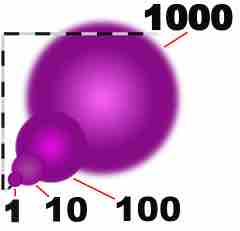Limiting Effects of Diffusion on Size and Development
The exchange of nutrients and wastes between a cell and its watery environment occurs through the process of diffusion. All living cells are bathed in liquid, whether they are in a single-celled organism or a multicellular one. Diffusion is effective over a specific distance and limits the size that an individual cell can attain. If a cell is a single-celled microorganism, such as an amoeba, it can satisfy all of its nutrient and waste needs through diffusion. If the cell is too large, then diffusion is ineffective at completing all of these tasks. The center of the cell does not receive adequate nutrients nor is it able to effectively dispel its waste.
An important concept in understanding the efficiency of diffusion as a transportation mechanism is the surface-to-volume ratio. Recall that any three-dimensional object has a surface area and volume; the ratio of these two quantities is the surface-to-volume ratio. Consider a cell shaped like a perfect sphere: it has a surface area of 4πr2, and a volume of (4/3)πr3. The surface-to-volume ratio of a sphere is 3/r; as the cell gets bigger, its surface-to-volume ratio decreases, making diffusion less efficient . The larger the size of the sphere, or animal, the less surface area for diffusion it possesses.

Surface-to-volume ratio
The image illustrates the comparison of spheres of one to one thousand volume units. The surface-to-volume ratio of a sphere decreases as the sphere gets bigger. The surface area of a sphere is 4πr2 and it has a volume of (4/3)πr3 which makes the surface-to-volume ratio 3/r. This has an effect on diffusion because it relies on the surface area of a cell: as a cell gets bigger, diffusion becomes less efficient.
The solution to producing larger organisms is for them to become multicellular. Specialization occurs in complex organisms, allowing cells to become less efficient at completing all tasks since they are now more efficient at doing fewer tasks. For example, circulatory systems bring nutrients and remove waste, while respiratory systems provide oxygen for the cells and remove carbon dioxide from them. Other organ systems have developed further specialization of cells and tissues and efficiently control body functions. Surface-to-volume ratio also applies to other areas of animal development, such as the relationship between muscle mass and cross-sectional surface area in supporting skeletons or in the relationship between muscle mass and the generation of dissipation of heat.